Nepal is a haven for trekkers, offering stunning Himalayan views, golden temples, picturesque hill villages, and exciting jungle wildlife experiences, making it one of the world’s top travel destinations.

Kathmandu’s Hanuman Dhoka, the royal palace, traces its origins back to the Licchavi period (4th to 8th centuries AD) but was significantly expanded in the 17th century by King Pratap Malla. Unfortunately, much of the palace was severely damaged during the 2015 earthquake. As of the latest update, the main Nasal Chowk courtyard remains open, and the Tribhuvan Museum was nearing its reopening, with other buildings still under restoration.
The palace’s exterior is captivating, especially the iconic statue of Hanuman, the monkey god, which marks the palace entrance. This statue, dating from 1672, is coated in orange vermillion paste by generations of devotees. Hanuman’s image is a reference to his role in the Ramayana, assisting Lord Rama. Two lions, representing Shiva and Parvati, stand guard at the gate, and a brightly painted niche above the gate features a Tantric depiction of Krishna, flanked by a gentler Krishna and King Pratap Malla with his queen.
Originally containing 35 courtyards, the palace now has just 10, following the destruction caused by the 1934 earthquake.
Nasal Chowk Nasal Chowk is the main courtyard inside the royal palace. Built during the Malla period, many of the surrounding buildings are from the later Rana period. This square was once the site of coronations, including King Gyanendra’s in 2001. In the center stands a former coronation platform, while the damaged Basantapur Tower looms at the southern end. The Narsingha Statue, depicting Vishnu as a man-lion, stands at the entrance to the courtyard. This stone statue, installed in 1673 by King Pratap Malla, commemorates the king’s fear of having offended Vishnu by dressing as Narsingha.
Nasal Chowk also houses the Sisha Baithak (Audience Chamber), where the Malla kings held court, and displays of royal palanquins, including those used during Queen Aishwarya’s wedding and funeral. The Panch Mukhi Hanuman Temple stands at the northeastern corner of the square, and a Dancing Shiva statue is hidden in the whitewashed chamber on the northeastern side of the square.
Tribhuvan Museum The western wing of the palace, overlooking Durbar Square, was built by the Ranas in the mid-to-late 19th century and later became the Tribhuvan Museum, celebrating King Tribhuvan’s revolt against the Rana regime. The museum was severely damaged in the 2015 earthquake, and it remains unclear whether the treasures, including King Tribhuvan’s stuffed bird and his scarred Land Rover, survived. Above the museum stands the nine-storey Basantapur Tower, which was partially destroyed in the earthquake and is currently closed for repairs.
Lohan Chowk & Mul Chowk Lohan Chowk is under renovation, and Mul Chowk, located just north of it, is dedicated to religious functions. The Mul Chowk features a two-storey building surrounding a courtyard and is home to the royal goddess Taleju Bhawani, to whom sacrifices are made during the Dasain festival. Access is restricted to Hindus, but views are available from Nasal Chowk.
Mohankali Chowk & Sundari Chowk North of Nasal Chowk lies a beautifully carved doorway leading to the private quarters of the Malla kings. The first courtyard, Mohankali Chowk, was built in 1649 and was historically a place where a Malla king had to be born to be eligible for the throne. Sundari Chowk, behind it, is home to a ritual bathing pool with a 6th-century carving of Krishna and the Kaliya serpent, hewn from a single block of stone. This area was also damaged in the 2015 earthquake and remains closed for reconstruction.
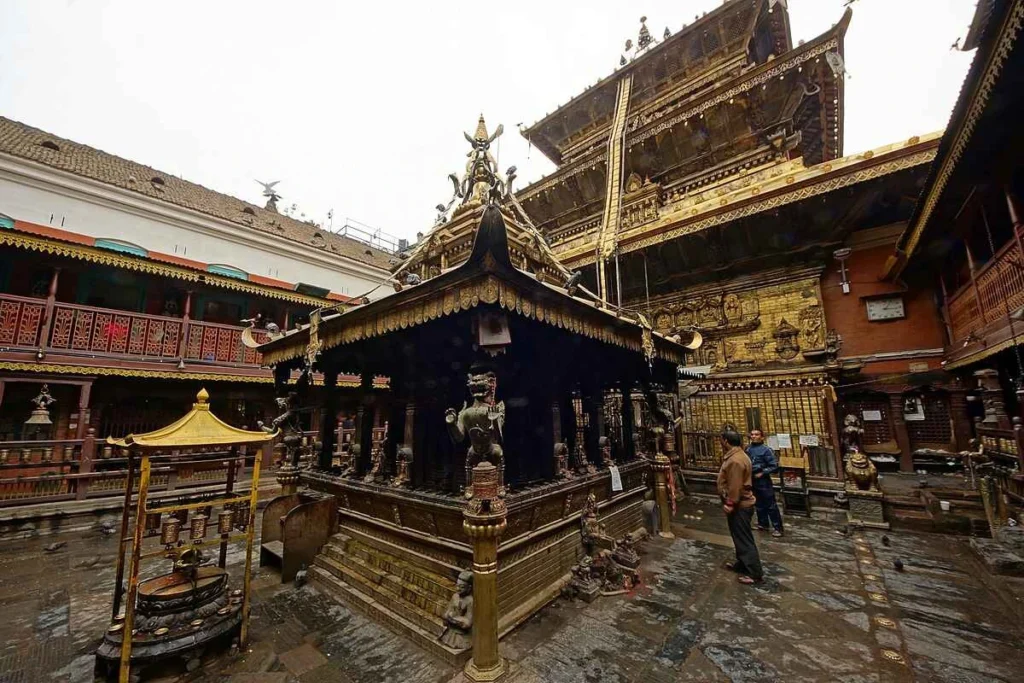
The Golden Temple, a unique Buddhist monastery just north of Durbar Square, was allegedly founded in the 12th century and has existed in its present form since 1409. It derives its name from the gilded metal plates that adorn much of its frontage, making it one of the most beautiful temples in Patan.
Visitors can enter through an ornate stone doorway to the east or a wooden doorway to the west, which leads to one of the interlinked courtyards on the north side of Nakabhil. Entering from the east, you’ll pass gaudy lions and notice the 1886 signature of Krishnabir, the master stonemason who sculpted the fine doorway, complete with a frieze of Buddhist deities. This second doorway leads to the main courtyard of the Golden Temple, where shoes and leather items must be removed to enter the lower courtyard.
The temple’s main priest is a young boy under the age of 12, who serves for 30 days before passing on the role to another boy.
The temple is an excellent example of courtyard temple architecture. Two elephant statues guard the doorway, and the facade is covered with a series of gleaming Buddhist figures. Inside the main shrine, you’ll find a beautiful statue of Sakyamuni (no photos allowed). To the left of the courtyard is a statue of Green Tara, while the right corner houses a statue of the Bodhisattva Vajrasattva, dressed in an impressive silver-and-gold cape. Both of these statues are housed in inner shrines.
Facing the main temple is a smaller shrine containing a ‘self-arisen’ (swayambhu) chaitya. The four corners of the courtyard feature statues of four Lokeshvaras (incarnations of Avalokiteshvara) and four monkeys holding jackfruits as offerings. A stairway leads up to an upper-floor chapel dedicated to a white eight-armed Avalokiteshvara, adorned with Tibetan-style frescoes, including a wheel of life. As you exit through the eastern exit, look up to see an embossed mandala on the ceiling. Outside of winter, you might spot tortoises roaming around the compound, serving as temple guardians.
A short walk south towards Durbar Square reveals the small two-tiered Uma Maheshwar Temple and the striking Gauri Shankar Temple, built in the Indian shikhara style. Across the road is the Maru Mandapa Mahavihar, a Buddhist complex set in a small courtyard.
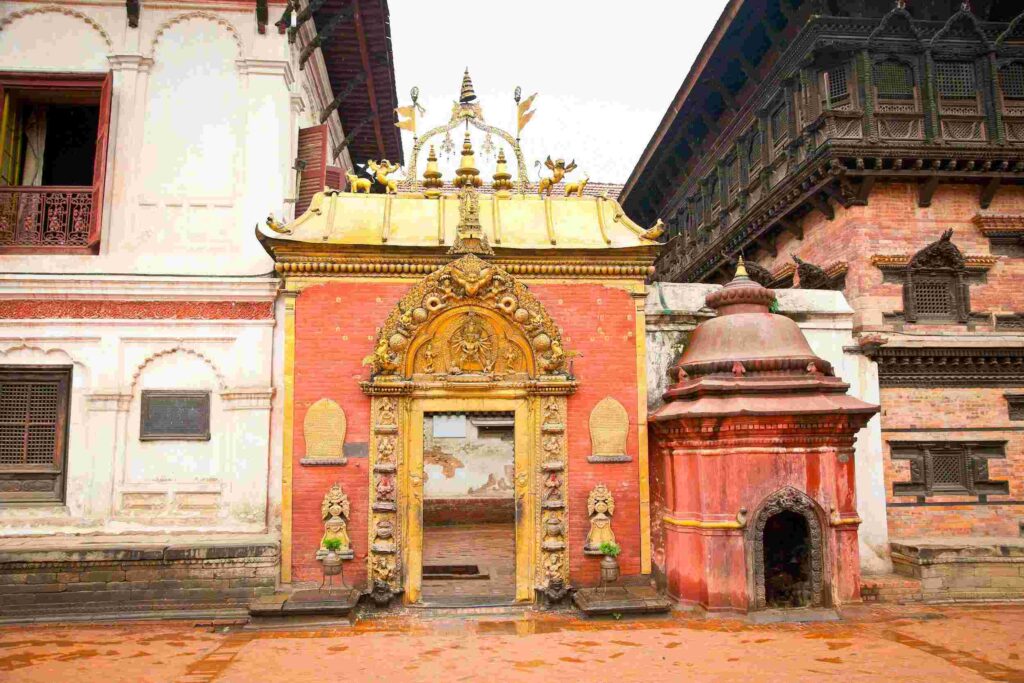
The Golden Gate, a magnificent visual highlight of Durbar Square, is set into a vibrant red gatehouse surrounded by the white palace walls. This stunning golden portal features some of Nepal’s finest repoussé metalwork. The gilded torana above showcases a dramatic depiction of Garuda wrestling with several supernatural serpents. Beneath it, a four-headed, ten-armed figure of the goddess Taleju Bhawani, the family deity of the Malla kings, stands as a focal point.
Construction of the gate began during the reign of King Bhupatindra Malla (r. 1696–1722) and was completed by his successor, Jaya Ranjit Malla, in 1754. The death of Jaya Ranjit Malla marked the end of the Malla dynasty and the conclusion of the golden age of Newari architecture in Nepal.
The gate leads into the inner courtyards of the Royal Palace, once a vast compound with 99 courtyards, though the 1934 earthquake destroyed most of them. More walls collapsed during the 2015 earthquake. To the right of the Golden Gate stands the 55-Window Palace, so named for the 55 intricately carved wooden windows that stretch along its upper level.
Upon entering the palace complex, you’ll notice a pair of enormous war drums hidden behind grills in the darkness on either side of the inner gate. These drums were once used to alert the city in the event of an attack. Continuing along, you’ll pass two statues of traditionally dressed guards standing beside an ornate door, which were brought here from Rajasthan.
The journey then leads to the main entrance of Mul Chowk, the oldest part of the palace, where the Taleju Temple stands. Built in 1553, this temple is one of the most sacred in Bhaktapur. Although damaged in the earthquake, it remains intact. Only Hindus are allowed inside, but visitors can admire the temple’s entrance, adorned with magnificent wood carvings (photography is prohibited).
Around the corner from Mul Chowk lies Naga Pokhari, a 17th-century water tank once used for the ritual immersion of the Taleju idol. The pool is surrounded by a writhing stone cobra, and other serpents rise from the middle and end of the tank, where water pours from a magnificent dhara (spout) in the shape of a goat being devoured by a makara.

The first stupa at Boudhanath was built sometime after AD 600, following the conversion of the Tibetan king Songtsen Gampo to Buddhism. In terms of elegance and purity of design, Boudhanath stands unmatched among Nepal’s stupas. Its whitewashed dome and the gilded tower, adorned with the Buddha’s all-seeing eyes, are perfectly proportioned, creating an aura of grace and serenity. To experience the best atmosphere, join the Tibetan pilgrims during their morning and evening koras (circumambulations) around the stupa.
Legend has it that King Songtsen Gampo constructed the stupa as an act of penance after accidentally causing his father’s death. The original stupa was destroyed by Mughal invaders in the 14th century, and the current structure is a more recent reconstruction.
Symbolically, the stupa serves as a three-dimensional representation of the Buddha’s path to enlightenment. The plinth symbolizes earth, the dome (kumbha) represents water, the square tower (harmika) signifies fire, the spire embodies air, and the umbrella at the top represents the void or ether beyond space. The 13 levels of the spire symbolize the stages a person must pass through to reach nirvana.
Stupas were originally built to house sacred relics, and there are claims that Boudhanath contains relics of the past Buddha, Kashyapa, while others believe it holds a bone from the skeleton of Siddhartha Gautama, the historical Buddha. Surrounding the base of the stupa are 108 small images of the Dhyani Buddha Amitabha, as well as a ring of prayer wheels, set in groups of four or five, within 147 niches.
To access the upper level of the plinth, look for the gateway at the north end of the stupa, next to a small shrine dedicated to Hariti (Ajima), the goddess of smallpox. The plinth is open from 5am to 6pm (extended to 7pm during summer), offering a raised viewpoint over the waves of pilgrims encircling the stupa. On the east side, you can witness dedicated devotees prostrating themselves full-length on the ground in deep reverence.

The long, rectangular courtyard of Itum Bahal is the largest bahal (Buddhist monastery courtyard) in the old town of Kathmandu, providing a peaceful retreat amidst the bustling surroundings. On the western side of the courtyard lies the Kichandra Bahal, one of the oldest bahals in the city, dating back to 1381. A chaitya at the entrance has been completely shattered by a Bodhi tree, which has grown up through its center.
Inside the Kichandra Bahal (or Keshchandra Paravarta Mahar Bihar) is a central sanctuary that resembles a pagoda. To the south of the sanctuary stands a small chaitya adorned with graceful standing bodhisattvas, adding to the tranquility of the space.
On the northern side of the courtyard, there are four brass plaques mounted on the upper-story wall, each telling a unique and intriguing story. The plaque on the far left depicts a demon named Guru Mapa, who is shown taking a misbehaving child from a woman and greedily stuffing it into his mouth. Eventually, the demon is appeased with an annual offering of buffalo meat. The plaque next to it shows Guru Mapa sitting down and dipping into a pot of food. This unusual narrative about juvenile misbehavior is particularly fitting, as the courtyard once housed a primary school, right beneath the Guru Mapa plaques.
To this day, every year during the festival of Holi, the people of Itum Bahal honor Guru Mapa by sacrificing a buffalo on the banks of the Vishnumati River. The buffalo is cooked in the afternoon within the courtyard, and at night, it is carried in large cauldrons to a tree in the Tundikhel parade ground, believed to be the demon’s residence.
In the autumn and winter months, the main square of Itum Bahal is beautifully decorated with intricate swirling patterns made from drying grain, adding a touch of art and tradition to the space.
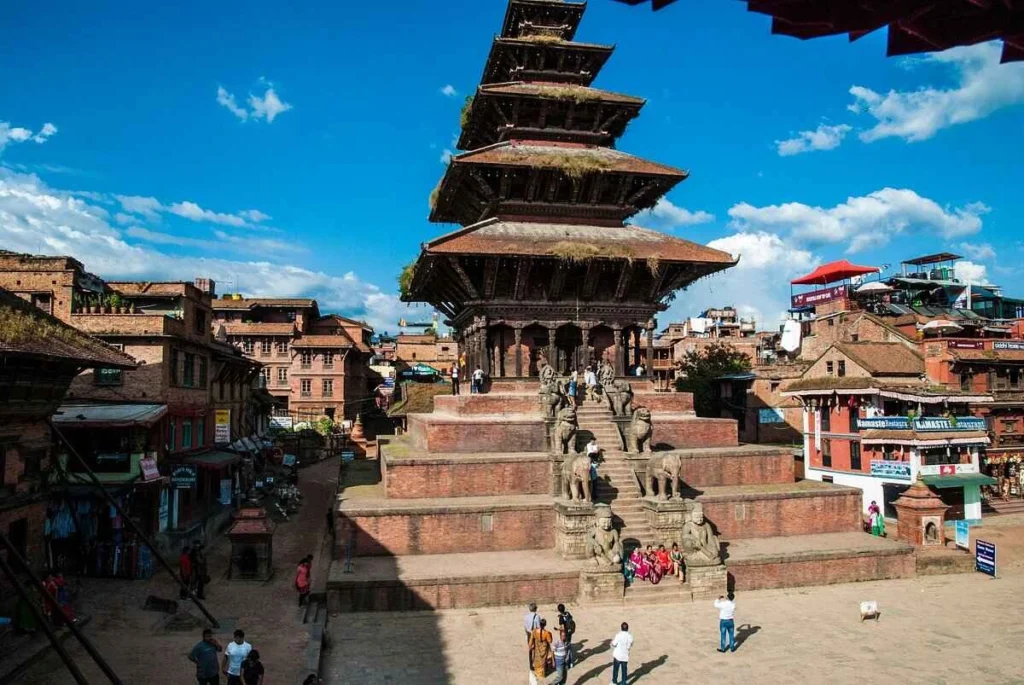
The Nyatapola Temple, towering 30 meters above Taumadhi Tole, is a striking landmark that you can spot from afar. This five-storey structure, the tallest temple in Nepal, stands as one of the tallest buildings in the Kathmandu Valley. Built in 1702 during the reign of King Bhupatindra Malla, the temple’s robust construction has withstood the 1934 and 2015 earthquakes with minimal damage.
To reach the temple, you must ascend a stairway flanked by stone statues of guardians. At the base, the legendary Rajput wrestlers Jayamel and Phattu are depicted kneeling with heavy maces. As you ascend, the guardians become more imposing: elephants with floral saddles, lions with bells, griffons with rams’ horns, and finally, the goddesses Baghini and Singhini. Each figure is said to be ten times stronger than the one below it.
The temple is dedicated to Siddhi Lakshmi, a fearsome incarnation of the goddess Durga (Parvati). The idol of Siddhi Lakshmi is so terrifying that only the temple’s priests are allowed to enter the inner sanctum. However, less intimidating representations of the goddess can be seen on the torana above the door, beneath a canopy of braided snakes, and on the 180 carved roof struts. In a fascinating mix of religious symbolism, the Buddhist eight lucky signs are also carved beside the temple doorways.
On the north side of the temple, you can spot the chariot runners, adding another element of interest to this majestic structure.
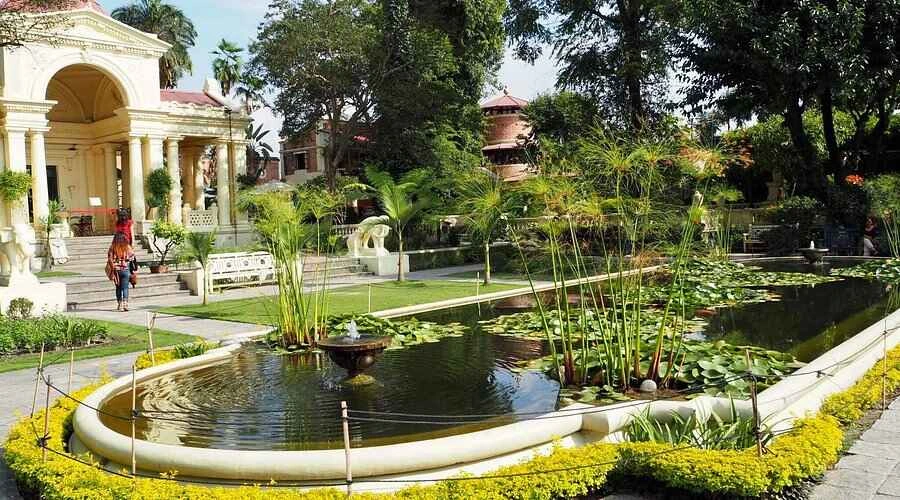
The beautifully restored Swapna Bagaicha, or the Garden of Dreams, is one of Kathmandu’s most serene and picturesque retreats, just two minutes’ walk from the bustling Thamel, yet offering a peaceful escape. Created in the 1920s by Field Marshal Kaiser Shamser (1892–1964), the garden was inspired by several Edwardian estates in England that he visited. He funded the project after winning Rs 100,000 in a legendary cowrie-shell game with his father, the prime minister.
Over time, the garden and its pavilions fell into disrepair, but after a six-year restoration completed in 2007 by an Austrian-financed team—who also worked on the Patan Museum—the space was lovingly brought back to life.
Though the original garden covered 1.6 hectares and featured six pavilions (each named after one of the six Nepali seasons), only half a hectare and three pavilions remain today. However, the details are still stunning. From the original gate and a marble inscription of Omar Khayyam’s Rubaiyat, to the new fountains and ponds, every corner of the garden offers something to admire. A hidden garden to the south adds a quirky charm to the space.
To fully enjoy the tranquility, visitors often bring books or picnics, settling on the provided lawn mats. While the garden is frequented by local couples, it retains its peaceful ambiance. The serene Kaiser Cafe, operated by Basera Boutique Hotel, serves as a great place to relax, and there are occasional cultural events and exhibitions. Wi-Fi is available for Rs 50 per hour, allowing you to stay connected if needed.
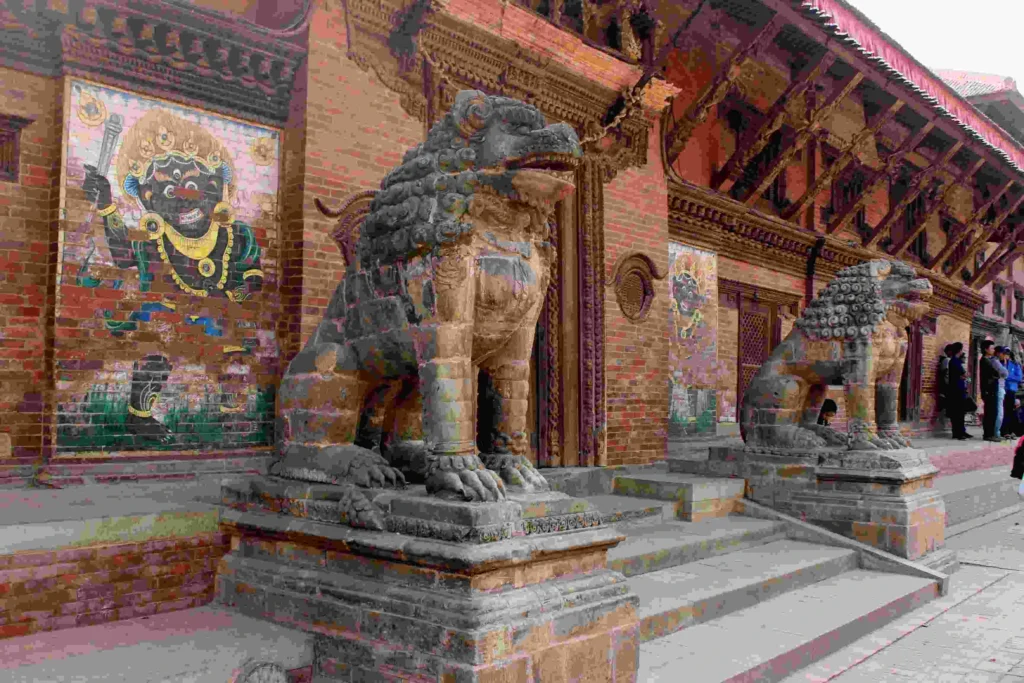
South of the Patan Museum lies Mul Chowk, the largest and oldest of the Royal Palace’s three main chowk (courtyards). Originally built in the 12th century, the buildings were destroyed by fire in 1662 but were rebuilt just three years later by Srinivasa Malla. After the 2015 earthquake, restoration efforts brought back the surrounding walls and buildings, with further restoration of the temples in 2014.
At the heart of Mul Chowk stands the small yet stunning Bidyapith Temple, its gilded frame shining in the center of the square. This temple is dedicated to Yantaju, a form of Durga, who was a personal deity of the Malla kings. Nearby, a wooden post, traditionally used for animal sacrifices, stands as a silent reminder of past rituals.
On the southern side of the square, you’ll find the Taleju Bhawani Temple. Flanked by statues of river goddesses—Ganga riding a tortoise and Jamuna on a makara—this temple is an architectural gem. The upper galleries now serve as part of the museum’s collection, showcasing exquisite carved wooden struts that provide a glimpse into Nepal’s craftsmanship.
To the northeast, the towering Degutalle Temple stands proudly with its octagonal, triple-roofed tower. Directly north, the larger Taleju Temple also rises, dedicated to Taleju, another protective deity revered by the Malla kings. Both temples add to the majesty of the square, offering a rich blend of history and sacred architecture.
WhatsApp us